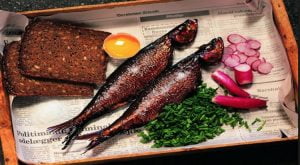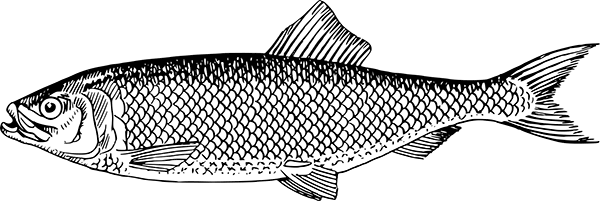On the hot-smoked herring delicacy that is buckling and its spiritual home in the small fishing town of Gudhjem on the Danish island of Bornholm
BUCKLING
Hot smoked herring, buckling has become more available in Britain with the development of specialist, delicatessen fish smokers. It seems to have originated in the Baltic, where they’ll hot smoke just about any fish they can catch.
Hot Smoking
This is a method of cooking the fish in the smoke of a hot wood fire. Hardwoods are preferred – from oak and beech to alder. The additional use of aromatic branches, such as juniper, is common. Improvised hot smoking kilns are common throughout the Baltic. Different temperatures are achieved for different parts of the process, but reach between 212ºF (100ºC) and 248ºF (120ºC) in the cooking period.
In the 1960s the Polish archaeologist Professor Z. Rajewski discovered thirty four pear-shaped holes and sixteen hearths, together with the bones of pike, bass, roach, bream and catfish, in Biskupin, to the south of Gdansk. They indicate a hot smoked fish production that thrived between the C8th and C10th.
It is impossible to date the earliest experiments with bücklinge, but it may have been one of the forms of ‘dried’ herring in use before the German Hanse levered a takeover of the Vikings’ trading empire through control of the salt they brought to the Skåne herring boom. Strohbücklinge, hard-smoked and packed with straw, would keep for two to three weeks. It is possible that there were even harder-smoked varieties that lasted longer.
Bornholm
The undisputed heartland of buckling is the Danish island of Bornholm. Production here is in brick kilns, roughly 10 ft square, narrowing towards the top like a decapitated pyramid. Fires, preferably made of alder, are raked backwards and forwards across the floor, or moved about on trolleys, to give an even distribution of heat.
The herrings are usually gutted, then salted for half an hour before being dried, toughening the head and skin so that they do not fall off their sticks in the cooking. Sometimes they are smoked unsalted, but sprinkled with salt when packed. They are cooked in a thick smoke for between 1 ½ and 2 hours, the heat raised gradually from around 60º C to roughly 100º C.

The great buckling dish is Sol over Gudhjem (Sun over Gudhjem), in which it is served whole or filleted with a raw egg yolk and range of trimmings, from chives to radishes. If you go to Bornholm, you can visit the small fishing town of Gudhjem and eat Sol over Gudhjem in the sunshine while looking out across the sea. You can also visit the Oluf Høst Museet there and see Høst’s paintings of herring smoking kilns.
